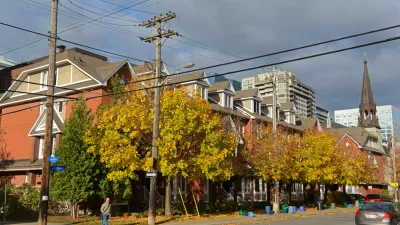The first study to make an attempt at quantifying the value of "eyes on street"—an idea most eloquently described by Jane Jacobs—offers reason to support a mix of uses, with businesses operating later in the evening.

"In June, a team of researchers released a paper, titled 'Analysis of Urban Vibrancy and Safety in Philadelphia,' that attempts to begin a quantitative analysis of Jacobsian theory by bringing together publicly available data sets related to crime, business activity and the built environment," according to an article by Jared Brey.
Three statisticians from the Wharton School at the University of Pennsylvania conducted the study, investigation "the correlations between public safety and population density, population count, zoning, business activity, and business hours."
Brey details the study's methodology and summarizes its findings. One conclusion to draw from the study: that busineses should be allowed to operate at longer hours. According to Shane Jensen, a statistics professor at Wharton, the findings are tentative but should still give planners and city officials reasons to think about the effect of businesses in a neighborhood.
FULL STORY: Philly Streets Get Test of Jane Jacobs’ “Eyes on the Street” Effect

Trump Administration Could Effectively End Housing Voucher Program
Federal officials are eyeing major cuts to the Section 8 program that helps millions of low-income households pay rent.

Planetizen Federal Action Tracker
A weekly monitor of how Trump’s orders and actions are impacting planners and planning in America.

The 120 Year Old Tiny Home Villages That Sheltered San Francisco’s Earthquake Refugees
More than a century ago, San Francisco mobilized to house thousands of residents displaced by the 1906 earthquake. Could their strategy offer a model for the present?

HSR Reaches Key Settlement in Northern California City
The state’s high-speed rail authority reached an agreement with Millbrae, a key city on the train’s proposed route to San Francisco.

Washington State Legislature Passes Parking Reform Bill
A bill that would limit parking requirements for new developments is headed to the governor’s desk.

Missouri Law Would Ban Protections for Housing Voucher Users
A state law seeks to overturn source-of-income discrimination bans passed by several Missouri cities.
Urban Design for Planners 1: Software Tools
This six-course series explores essential urban design concepts using open source software and equips planners with the tools they need to participate fully in the urban design process.
Planning for Universal Design
Learn the tools for implementing Universal Design in planning regulations.
Ada County Highway District
Clanton & Associates, Inc.
Jessamine County Fiscal Court
Institute for Housing and Urban Development Studies (IHS)
City of Grandview
Harvard GSD Executive Education
Toledo-Lucas County Plan Commissions
Salt Lake City
NYU Wagner Graduate School of Public Service




























